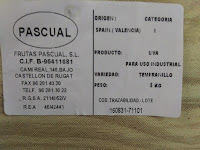 |
| Cheeky mushrooms all over the place |
On advice from Roger White from Yearlstone Vineyard, who told us you could mix different sprays in your own preparation, we sometimes mixed sulphur, copper sulphate and liquid seaweed together with the milk to make foul smelling, sometimes cheesy liquid which we were sure must do something.
 |
| Mildewed Bacchus. Note the milk residue on the leaves. |
Alas no. Either our spraying technique was to blame (you are supposed to spray the underside of the leaves but that was too much of a fag) or as we said, the whole think was cockamamie. Next year - chemicals.
It had all started so positively. The pruning was not too demanding as we decided that the summer pruning of the Triomphe should serve and we would see what happened if we left those vines alone (about one-third of the total). This turned out not to make much difference apart from the fact that we had to carry out drastic summer pruning again later on.
 |
| Bacchus before |
 |
| and after |
 |
| note mild hailstorm. |
Manure? Yes, surely that is where we had been going wrong all these years. We read about how you have to feed the vines and how the French spread tons of the stuff all over the vineyard. You are supposed to dig it in or plow it of course but again, we weekenders don't have the time for those sorts of refinements. No wonder it seemed to make no difference apart from encouraging the weeds.
All those weeds required some strimming later on. More backbreaking stuff, enlivened by the discovery of various eggs under a couple of vines. Probably from pheasants who knows when.
In the hopeful stage before the mildew had set in, there was even for the very first time a flowering on our wierdest vine in the vineyard. This is obviously some kind of scientifically berserk crossing with some triffid-like germplasm. Every year we cast a baleful eye on this plant and take care to keep its ridiculously vigorous tentacles off its neighbours. It has never born fruit. The only positive thing you can say about it is that it is impervious to mildew or any other illness. Sadly, this fruit was not to develop and later was nowhere to be seen. Never mind. It would probably have been sour.
As has been mentioned in this blog already from time to time, we actually grew some vines from bare wood cuttings in 2016. They were less of a success than we anticipated at one stage. Nonetheless we were able to plant
4 x Baco Noir
4 x Saperavi Severny
1 x Abouriou
1 x Acadie Blanc
1 x Rauschling
1 x Elbling
Of these, only the Elbling didn't survive the planting out. Indeed the Baco Noir, Saperavi Severny and Acadie Blanc turned out to be quite vigorous customers.
During the season we also bought 4 x Pinot Blanc at a knockdown price online from a Dutch nursery (3 survived), a Black Hamburgh (Schiava Grossa) from the local garden centre which was very vigorous indeed until some animal denuded it of all its leaves above the rabbit guard and a half-price Muscat d'Alexandrie which we were told should probably be grown indoors. Well, we do call it an experimental vineyard.
The baby red grapes in our more recent plantings (Rondo, Regent, Dornfelder, Pinot Noir, Wrotham Pinot (Pinot Meunier) and Fruehburgunder were a mixed bag. In general the vigour of these vines is poor where we have planted them.
Some predator (wasps? Birds?) always go for our Rondo first.
So our hope are pinned once again on the 'mal-aimé' Triomphe. This time we are thinking of making it by the Carbonic Maceration method having been inspired by the Ancre Hill Triomphe we had tasted at the Real Wine Fair earlier in the year.
As anyone with any knowledge of Viticulture and Winemaking reading this post will have determined from the start, we are not exactly gifted at either discipline and have close to zero aptitude. Nonetheless, we are game so one rainy Friday morning we paid a call to Eskimo Ice at Nine Elms Market in London next to New Covent Garden to buy some food grade dry ice.
From there to Hatfield to buy some grapes. The idea was to make an experimental run at this Carbonic Maceration mularky before subjecting our own crop to it. Basically you put whole bunches of grapes in an airtight container, fill it with Carbon Dioxide and seal it with an airlock. In three weeks, the grapes are supposed to ferment from the inside out.
 |
| Winegrapes Chris |
Chris has a tremendous operation in Hatfield. he sells grapes from Italy (Puglia) and Spain (Valencia) to the various communities throughout the UK. The communities then make the wine at home like in the old country. We have met practitioners as far away as Edinburgh. The varieties on offer included
 | ||||||||||
as well as a newcomer, Macabeo. We decided to buy Sangiovese and Trebbiano.
Back at the ranch we had a bit of difficulty with the dry ice. It will only release its CO2 when in contact with water. We didn't think water in the bottom of the fermenter would be a good thing so we layered some dry ice pellets in with the bunches of Sangiovese.
Some of the grapes had burst and thiis provided the liquid for the dry ice to release the gas. Unfortunately we had probably put far too much in because the action was over-dramatic. Since then - nothing, although the three weeks aren't yet up at the time of writing.
With the rest of the grapes we hurriedly made red and white micro-vinifications. Try this at home!
 |
| Trebbiano plug |
 |
| Sangiovese must |
We'll be sure to report on how all this turns out.


















No comments:
Post a Comment